Recently, NITI Aayog’s Frontier Tech Hub unveiled the document titled “Reimagining Agriculture: A Roadmap for Frontier Technology-Led Transformation” in Gandhinagar, Gujarat.
About NITI Aayog’s Frontier Tech Hub
- The NITI Frontier Tech Hub is an action tank for Viksit Bharat.
- Long Term Vision: Collaborating with over 100 experts across government, industry, and academia, it is developing 10-year thematic roadmaps spanning 20+ sectors to harness frontier technologies for transformative, inclusive growth.
- Future-Ready India 2047: The Hub drives coordinated action today to build a prosperous, resilient, and technologically advanced India by 2047.
|
Crucial Insights on recent NITI Aayog’s Reimagining Agriculture Report
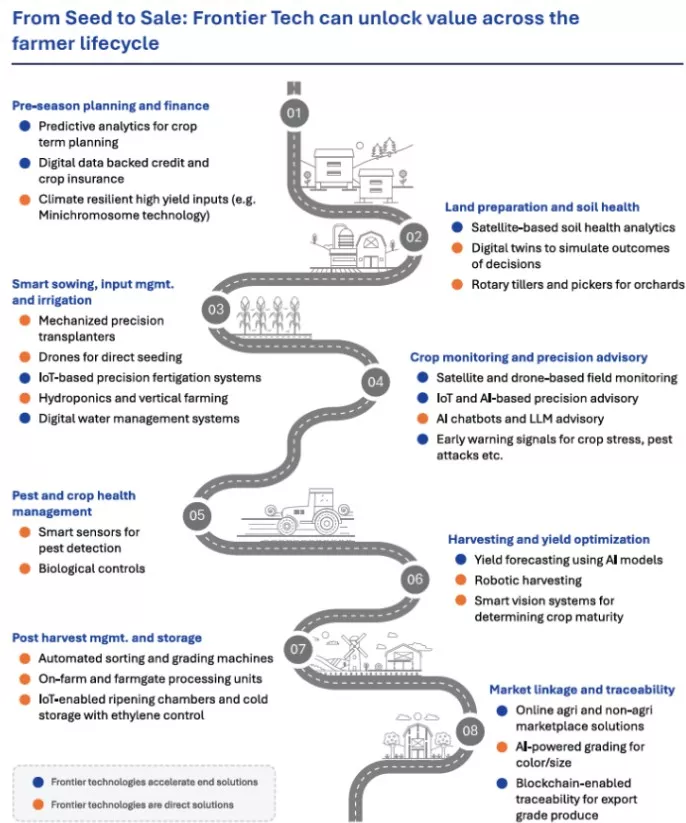
- The comprehensive roadmap focuses on adopting Artificial Intelligence (AI), Machine Learning (ML), Internet of Things (IoT), Drones, and Satellite Imaging to revolutionize India’s agricultural landscape.
- Aim: o enhance productivity, sustainability, and farmer income through data-driven and technology-enabled interventions.
- Alignment with Viksit Bharat 2047: Aligned with the vision of Viksit Bharat by 2047 to tackle emerging challenges in agriculture and ensure long-term growth, resilience, and food security.
- Paradigm Shift in Agricultural Growth: The roadmap envisions a transition from traditional, input-led growth to a technology-enabled, intelligence-driven model, redefining the future of Indian agriculture.
- Customized Technological Interventions: Through emerging technologies, the roadmap promotes tailored solutions that enhance agricultural resilience, foster inclusive rural prosperity, and strengthen India’s global competitiveness in agri-tech.
- Three Strategic Pillars: The three main pillars of the roadmap focus on creating a robust, technology-integrated agricultural system:
- Enhance: Strengthening foundational systems, such as data ecosystems, and digital tools for last-mile delivery of agricultural solutions.
- Reimagine: Future-proofing India’s agriculture innovation ecosystem, focusing on translational research and development and industry-aligned talent systems.
- Converge: Building platforms for public-private dialogue, facilitating agile policy-making, and accelerating the transformation process through collaborative efforts.
- Technology Interventions for Smart and Sustainable Agriculture:
- Precision and Smart Farming: Integration of AI-powered crop monitoring, drone and satellite imaging, and climate-resilient seed technology to optimize water, fertilizer, and input use while improving yield and sustainability.
- Advanced Mechanization: Deployment of automated machinery for harvesting, sorting, and grading to reduce labor costs and enhance operational efficiency.
- Digital Twins and Predictive Analytics: Use of AI and digital twin models to simulate agricultural environments, enabling data-driven decision-making and predictive planning for improved productivity.
- Seed Innovation: Application of CRISPR, biofortified, and climate-resilient seed varieties to boost crop yield, resilience, and nutritional quality.
- AI-Powered Advisory Systems: Implementation of AI-based real-time advisories, as demonstrated in Telangana’s AI pilot, to help farmers make informed decisions, increase yield, and reduce input costs.
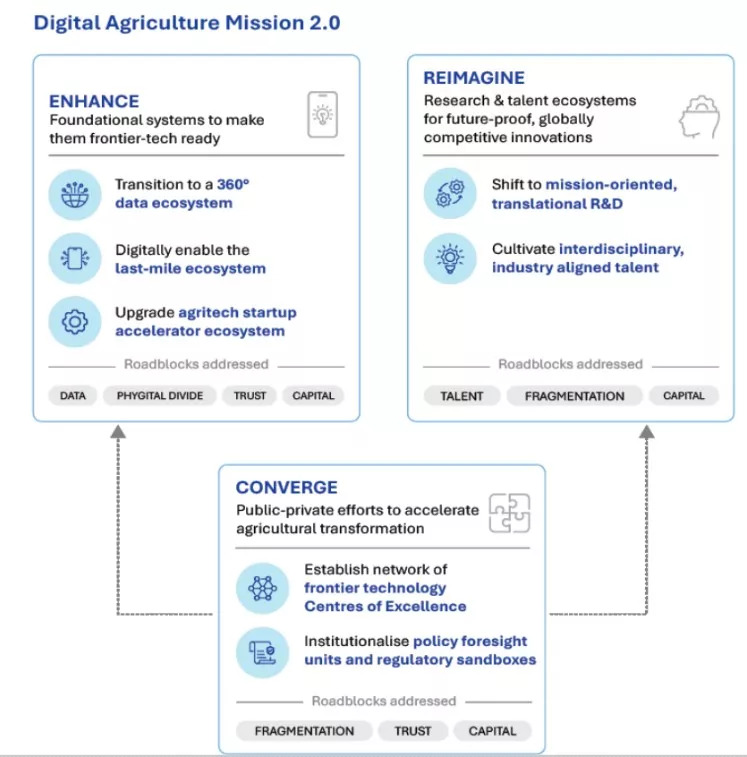 Farmer Segmentation and Tailored Solutions: To address the diverse agricultural needs across India, farmers have been classified into three primary archetypes based on their income, landholding, irrigation access, and technological adoption:
Farmer Segmentation and Tailored Solutions: To address the diverse agricultural needs across India, farmers have been classified into three primary archetypes based on their income, landholding, irrigation access, and technological adoption:-
- Aspiring Farmers (70–80%): Small, rain-fed farmers with low-tech adoption and high-risk, low-margin farming.
- Transitioning Farmers (15–20%): Medium-sized farmers with access to irrigation, beginning to adopt advanced technologies but facing challenges in scaling.
- Advanced Farmers (1–2%): Large-scale, tech-savvy farmers, often involved in commercial farming, seeking innovative solutions to boost yield and compete globally.
- Digital Agriculture Mission 2.0: The roadmap proposes advancing the Digital Agriculture Mission to include a 360° data ecosystem, an enhanced agri-tech startup accelerator, and digitized last-mile delivery systems.
About Frontier Technology
- Frontier technologies refer to advanced innovations that push the boundaries of existing systems. In agriculture, this includes:
- Climate-resilient Seeds: Genetically modified or bio-engineered crops designed to withstand climate shocks.
- Artificial Intelligence & Machine Learning: To analyze real-time data for predictive farming, optimizing inputs like water, fertilizers, and pesticides.
- Internet of Things (IoT) and Sensors: For precision agriculture, enabling farmers to monitor soil health, irrigation, and crop conditions remotely.
- Drones and Satellite Imaging: For crop monitoring and pest control, improving farm management efficiency.
- These technologies aim to shift farming from traditional methods to more data-driven, tech-enhanced systems that improve output and reduce costs.
|
Relevance and Implications
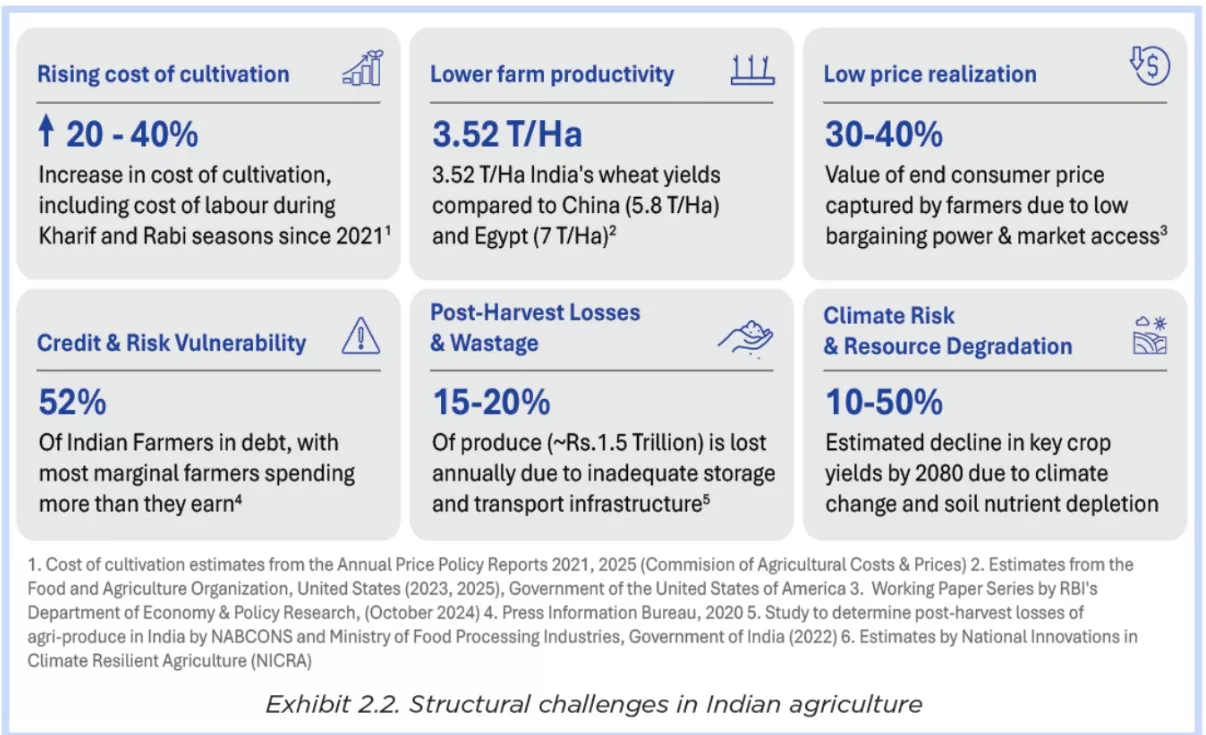
- Productivity and Income Growth: By focusing on precision agriculture and digital tools, the roadmap aims to raise yields, reduce input costs, and improve net incomes of farmers.
- Sustainability and Climate Resilience: Climate-resilient seeds and data-driven agronomy will help mitigate risks from erratic weather and resource constraints.
- Technology Diffusion and Access: Tailoring interventions according to farmer categories ensures that even smallholders benefit from frontier technologies, reducing the digital divide in agriculture.
- Global Competitiveness: India’s push aligns domestic agriculture with global innovation trajectories, positioning the agri-tech sector as a strategic growth domain.
- Role of States and Federated Implementation: Gujarat’s example shows how state-level innovations can accelerate national rollout; such models can be replicated across federal frameworks.
Current Indian Agricultural Landscape
- Foundation of Livelihoods: Agriculture employs 45.8% of India’s workforce and produces nearly 1 billion tonnes of food annually, serving as the backbone of food security, employment, and inclusive growth.
Key Challenges in Indian Agriculture and Technology Adoption
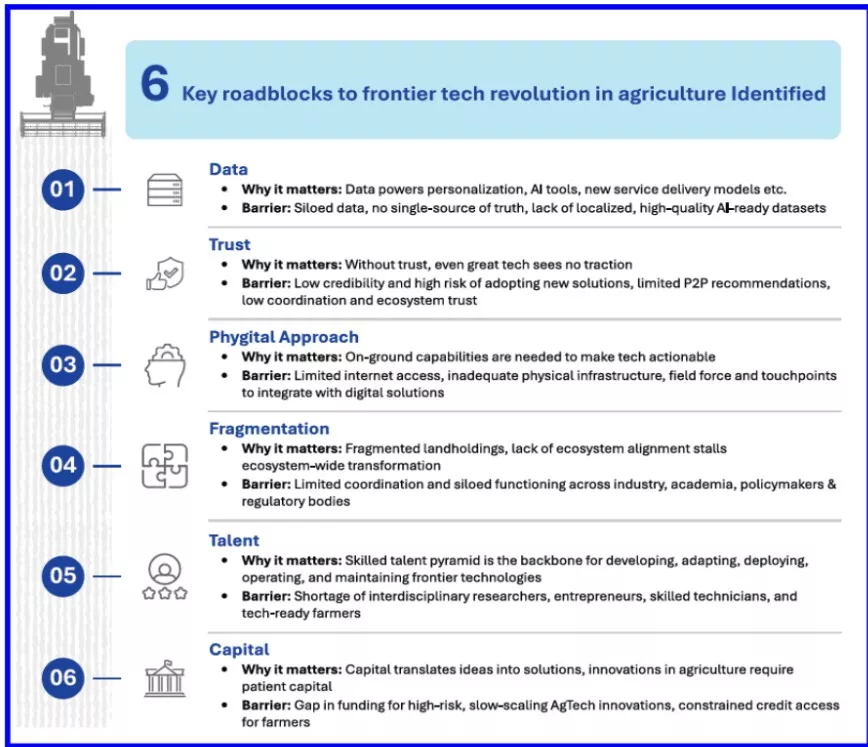
- Persistent Structural Issues:
- Fragmented Landholdings: Around 86% of farmers are smallholders with less than 1 hectare on average.
- Low Mechanisation: High reliance on manual and resource-intensive practices limits efficiency and scalability.
- Post-Harvest Losses: Estimated at over USD 18 billion annually, severely reducing farmer incomes.
- Digital & Financial Gaps: Restricted access to credit, insurance, and digital infrastructure curtails modernization.
- Climate Pressures: Increasing rainfall variability, soil degradation, and declining groundwater threaten both productivity and long-term sustainability of Indian agriculture.
- Data and Digital Gaps: Fragmented and non-standardized data systems, along with weak digital infrastructure in rural areas, hinder the adoption of AI-powered precision farming, IoT-based monitoring, and real-time decision-making.
- Poor internet connectivity and inadequate physical infrastructure further limit digital integration.
- Low Trust and Tech Awareness: Farmers’ skepticism about the reliability, maintenance, and effectiveness of new technologies—especially in remote regions—creates a trust deficit that slows the pace of technology adoption and innovation diffusion.
- Financial and Capital Constraints: High technology costs, limited access to institutional credit, and insufficient funding for high-risk agri-tech innovations restrict adoption.
- The lack of viable financial models for startups and smallholders further reduces large-scale technology diffusion.
- Skill and Talent Deficit: The shortage of interdisciplinary researchers, skilled technicians, and tech-ready farmers weakens India’s ability to develop, adapt, and maintain frontier technologies critical for agricultural transformation.
- Structural Inefficiencies: Rising costs of cultivation, up by 20–40% in recent years, combined with low farm productivity, fragmented landholdings, and poor market access reduce profitability.
- Farmers often receive only 30–40% of the consumer price, reflecting low bargaining power and inefficient market systems.
- Climate and Resource Stress: Climate change and soil degradation are projected to cause a 10–50% decline in key crop yields by 2080, posing a serious threat to agricultural sustainability and food security.
- Regulatory and Ecosystem Readiness: Inadequate data governance, outdated seed regulations, absence of AI-advisory frameworks, and weak mechanization safety standards limit India’s readiness for large-scale, responsible adoption of agricultural technologies.
India’s Key Initiatives for Digital and Sustainable Agriculture
- Digital Agriculture Mission (2021–2025): Anchors India’s shift to a farmer-centric digital ecosystem through AgriStack, integrating land records, farmer databases, and AI-driven decision-support tools for data-based, precision agriculture.
- AgriStack and Agri Accelerator Fund: Serve as the digital backbone and innovation engine of Indian agriculture, enabling interoperable data platforms and supporting start-ups and frontier agri-tech solutions for scalable transformation.
- State-Level Digital Platforms (Gujarat Model): Initiatives like Digital Crop Survey, Agri Farm Registry, and i-Khedut Portal provide real-time crop data, digital access to schemes, and market connectivity, enhancing efficiency and transparency.
- Risk Management and Financial Inclusion: Pradhan Mantri Fasal Bima Yojana (PMFBY) ensures crop insurance and risk mitigation, while PM-Kisan and eNAM enhance income support and digital marketplace integration, empowering smallholders.
- Technology and Extension Reforms: The Kisan Drone Scheme drives precision spraying and mapping, and the National Mission on Agricultural Extension and Technology (NMAET) expands digital advisory, mechanization, and capacity-building systems for last-mile outreach.
- Sustainability and Infrastructure Support: The National Mission on Sustainable Agriculture (NMSA) promotes climate-resilient, eco-friendly practices, while Bharat Nirman Yojana strengthens rural infrastructure, ensuring digital and physical integration in agriculture.
- Digital Public Infrastructure for Agriculture (AgriStack): An initiative of the Government of India to create a unified digital ecosystem integrating farmer databases, services, and real-time data tools for efficient agri-service delivery.
Global Initiatives in Agricultural Transformation
- Artificial Intelligence for Agriculture Innovation (AI4AI): Led by the World Economic Forum, it scales AI and deep-tech solutions through public–private partnerships, promoting sustainable and climate-resilient farming.
- Global Initiative on Artificial Intelligence for Food Systems: Jointly launched by International Telecommunication Union (ITU), Food and Agriculture Organization (FAO), World Food Programme (WFP), and International Fund for Agricultural Development (IFAD) to advance AI-driven food systems, enhance productivity, reduce waste, and build climate resilience.
- Global Agricultural Technology Collaborations: Global actors, including the UN and leading agribusinesses, promote AI, robotics, and mechanization to enhance productivity and sustainability in global agriculture.
|
Way Forward
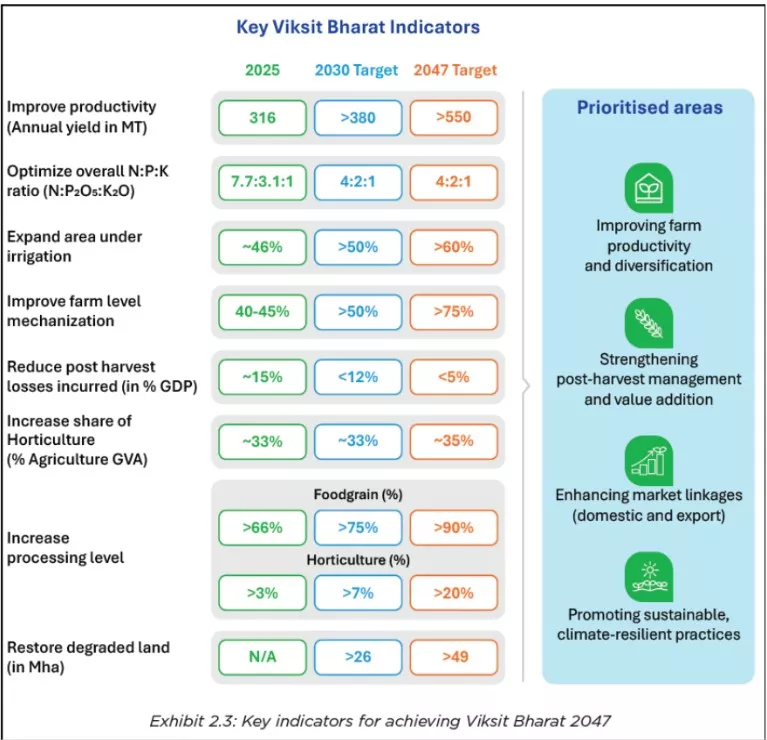
- Build a Unified Agri Data and Digital Ecosystem: Develop a decentralized, 360° “Agri Kosh” data framework integrating soil, weather, and crop data through GIS mapping and AgriStack expansion. Strengthen digital and internet infrastructure in rural areas to enable real-time, AI-driven decision-making and precision farming.
- Bridge the Phygital Divide and Strengthen Last-Mile Delivery: Adopt a hybrid approach combining digital tools (AI chatbots, mobile apps) with physical infrastructure (community centers, kiosks, FPOs).
- Empower local actors and extension agents to deliver hyperlocal advisories tailored to regional agro-climatic needs.
- Empower AgriTech Innovation and Startups: Enhance the AgriTech accelerator ecosystem by expanding capital access, promoting patient investments, and fostering R&D collaboration in high-impact areas like genomics, post-harvest management, and automation. Create an AgriTech Commons to pool infrastructure and scale solutions nationwide.
- Foster Public–Private–Research Collaboration: Establish Frontier Technology Centres of Excellence (CoEs) for mission-driven innovation. Introduce regulatory sandboxes and policy foresight units to safely test emerging technologies such as blockchain, drones, and AI advisories. Promote joint ventures to accelerate commercialization and adoption.
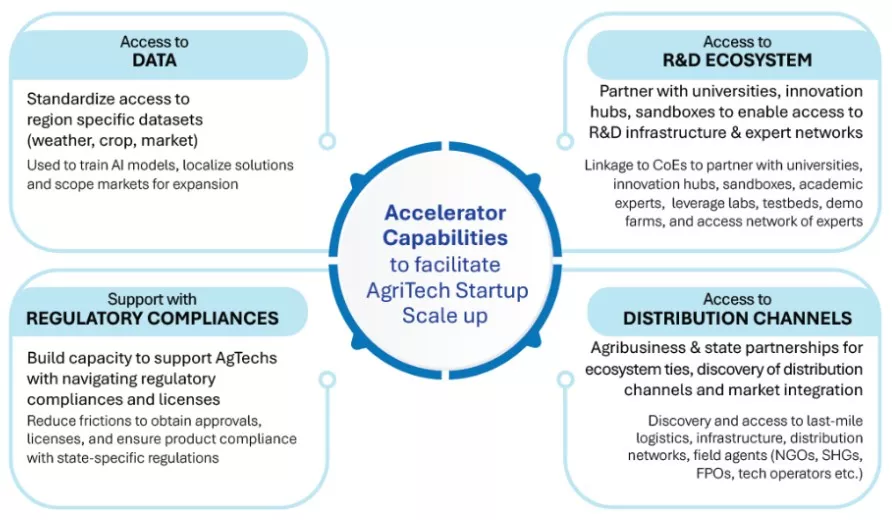 Build Human Capital and Agri-Tech Skills: Launch a National Agri-Tech Talent Framework to cultivate interdisciplinary expertise across farming, engineering, and data sciences. Integrate industry-aligned curricula, hands-on innovation hubs, and modular certifications to prepare farmers, researchers, and entrepreneurs for the digital agriculture era.
Build Human Capital and Agri-Tech Skills: Launch a National Agri-Tech Talent Framework to cultivate interdisciplinary expertise across farming, engineering, and data sciences. Integrate industry-aligned curricula, hands-on innovation hubs, and modular certifications to prepare farmers, researchers, and entrepreneurs for the digital agriculture era.- Strengthen Market Linkages and Ecosystem Integration: Address land fragmentation, low price realization, and post-harvest losses by improving market access, storage, and transport infrastructure. Expand digital price discovery and direct buyer platforms to ensure fair farmer income and create a connected, competitive agri-value chain.
Conclusion
By 2047, as India strives for developed nation status, agriculture—employing half the workforce—must drive this transformation. Leveraging frontier technologies can overcome structural barriers, ensuring a resilient, productive, and globally competitive agricultural ecosystem for a food-secure, prosperous India.
![]() 4 Nov 2025
4 Nov 2025


 Farmer Segmentation and Tailored Solutions: To address the diverse agricultural needs across India, farmers have been classified into three primary archetypes based on their income, landholding, irrigation access, and technological adoption:
Farmer Segmentation and Tailored Solutions: To address the diverse agricultural needs across India, farmers have been classified into three primary archetypes based on their income, landholding, irrigation access, and technological adoption:



 Build Human Capital and Agri-Tech Skills: Launch a National Agri-Tech Talent Framework to cultivate interdisciplinary expertise across farming, engineering, and data sciences. Integrate industry-aligned curricula, hands-on innovation hubs, and modular certifications to prepare farmers, researchers, and entrepreneurs for the digital agriculture era.
Build Human Capital and Agri-Tech Skills: Launch a National Agri-Tech Talent Framework to cultivate interdisciplinary expertise across farming, engineering, and data sciences. Integrate industry-aligned curricula, hands-on innovation hubs, and modular certifications to prepare farmers, researchers, and entrepreneurs for the digital agriculture era.